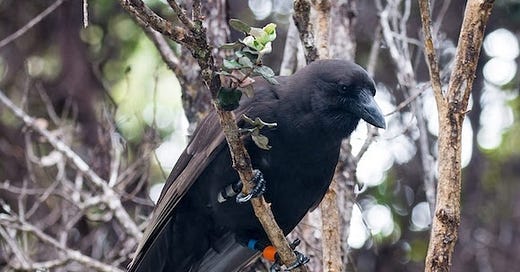The Hawaiian crow, or ʻalalā, went extinct in the wild in 2002. Still, for the past twenty years, hardworking scientists and conservationists have kept the species alive in specialized centers under human care, hoping to bring it back from the brink.
That time has finally arrived, and this year, eight juvenile ʻalalā have been released into the forests of Maui, near the Haleakalā volcano.
Resembling ravens more than crows, 19 to 20 inches in length, with a robust build, thick-curved bill, and blue eyes, alalā are fascinating, social, and intelligent birds that arrived on the Hawaiian archipelago before human settlement and adapted themselves to the unique environment of the islands. In addition to the fruits and seeds of their preferred native trees, these crows feed on certain flowering plants' nectar, assisting with pollination. They are Hawai'i's last surviving crow species and are found nowhere else on Earth. They are revered in local culture, and since their extinction in the wild, dedicated people have been preparing and planning for their return to the forests.
Hawaiian crows once inhabited the slopes of Mouna Loa and Hualālai at 3,000 to 6,000 feet. However, they began experiencing problems with an influx of human residents to the islands. Habitat loss due to humans, cattle, avian malaria, cats, mongooses, and hawks took an enormous toll on their population, eventually reducing it to just a few dozen individuals. To ensure the population would continue, even if it were only in captivity, eggs were taken from nests in the mid-1970s. Hawaiian crows live up to 18 years in the wild and 28 years in captivity.
Two previous reintroduction attempts on the Big Island were unsuccessful. Hawks, disease, and difficulty re-adapting to the wild caused high fatality rates. However, scientists believe they've learned hard lessons, making this new release much more successful.
This time, the crows were brought up to learn must-have skills in an anti-predator boot camp. Standins, including a stuffed barn owl, helped the crows recognize animals like hawks, cats, and owls and associate them with fear, alarm, and "mobbing" behavior. Only eight crows out of a murder of 115 crows that responded the best to their training were released into the wild.
Still, this cohort was released very slowly. After being transported to Maui, they were given time to acclimate under human protection. After release, they were fed food for a while. Crows are naturally curious and resourceful and quickly acquire needed skills. Tracking harnesses will keep scientists appraised and transmit reports if the newbies succeed.
While it will be tough for the black-legged, blue-eyed crows—and for all the folks helping Hawai'i "rewild" itself centuries after human settlement, Western annexation, and industrial agriculture—this is a bold step in the right direction that will lead to more biodiversity, healthier forests, and another success story of bringing back a beautiful animal from the brink.






After reading so much about the plight of the 'Akikiki lately, I'm uplifted to read this. Good luck out there, beautiful crows!
🖤🖤🖤🖤🖤🖤🖤